I’m thrilled to sit down with Christopher Hailstone, a renowned expert in energy management and renewable energy, whose insights into electricity delivery and grid reliability have shaped conversations around the future of clean tech. With a deep understanding of global trends, Christopher offers a unique perspective on how countries are navigating the shift to sustainable energy. In this interview, we dive into China’s remarkable journey from a perceived imitator to a global leader in clean energy innovation, exploring the policies, breakthroughs, and competitive dynamics behind this transformation. We also discuss how China’s advancements compare to other regions and what this means for the future of renewable energy.
Can you walk us through how China evolved from being viewed as a copycat in clean energy to a global innovator over the past two decades?
Absolutely, Carlos. Back around 2000, China was often criticized for replicating technologies developed elsewhere, with only a handful—about 18—of their clean energy patents considered internationally competitive. Fast forward to 2022, and that number skyrocketed to over 5,000 high-quality patents filed in multiple countries. This leap reflects a shift from imitation to genuine innovation, driven by a combination of strategic focus and sheer determination. China faced early challenges like limited technical expertise and underdeveloped infrastructure, but they turned those hurdles into opportunities by investing heavily in research and scaling up industries like solar power and batteries, where they now lead the world.
What role did the Chinese government play in driving this transformation into a clean energy powerhouse?
The government’s involvement has been pivotal. Through initiatives like the “Made in China 2025” program launched in 2015, they targeted key industries, including clean tech, with massive support—think low-interest loans, subsidies for research, and help acquiring foreign competitors. The goal was to dominate domestic markets, and they’ve largely achieved that. Beyond financial backing, the government fostered intense competition among companies, almost like a survival-of-the-fittest model. They’d flood an industry with support, let companies battle it out, and then scale back subsidies, leaving only the strongest to thrive and expand globally. It’s a ruthless but effective strategy.
How does China’s progress in clean energy innovation stack up against other major players like the United States or Europe?
Right now, China is ahead in several critical areas, particularly batteries and solar power, where their patent filings and market dominance are unmatched. In 2022, they filed more than twice as many high-quality clean energy patents as the U.S. However, Europe still holds an edge in wind energy and smart grids, areas where technical complexity and long-term investment have kept them competitive. When it comes to patent quality, China’s applications are increasingly robust, often filed in multiple countries to protect their innovations, though the U.S. and Japan still produce highly specialized, cutting-edge designs in certain niches. It’s a mixed landscape, but China’s volume and focus are hard to ignore.
Could you highlight some of the specific breakthroughs Chinese companies have made in clean energy technology?
Sure, let’s look at electric vehicle batteries as a prime example. Companies like BYD and CATL have revolutionized lithium-ion battery design by using iron and phosphate instead of pricier materials like nickel and cobalt. Their patented innovations have made batteries lighter, longer-lasting, faster to charge, and cheaper to produce. Beyond cost, they’ve tackled safety—CATL, for instance, developed technology to prevent catastrophic heat buildup and explosions during overcharging, which is a game-changer for consumer confidence in EVs. Outside of batteries, China’s also making strides in solar panel efficiency and scaling up production to levels that have reshaped global supply chains.
What do you think has been the key to China’s success in clean energy research and development?
It’s a combination of factors, but education and investment stand out. China has nearly 50 graduate programs dedicated to battery chemistry and metallurgy alone, producing a steady stream of skilled researchers. About 65% of widely cited technical papers on battery tech now come from Chinese researchers, compared to just 12% from the U.S. On top of that, the sheer scale of investment—far outpacing the West—has allowed them to build entire industries from scratch, controlling everything from raw materials to final products. Add to that a culture of aggressive competition encouraged by government policy, and you’ve got a recipe for rapid advancement.
Looking ahead, what is your forecast for the global impact of China’s dominance in clean energy technologies?
I think China’s role will only grow, especially as they pivot to emerging areas like carbon capture and smart grids, which are the next frontiers. Their dominance in batteries and solar already means the global energy transition is heavily reliant on their technologies—take China out of the equation, and innovation in some sectors might stagnate. However, this also raises questions about dependency and geopolitical tensions, especially as China tightens control over sharing key technologies. I expect other countries will need to ramp up their own investments significantly to balance this dynamic, or we’ll see an even more pronounced reliance on Chinese advancements in the fight against climate change.









